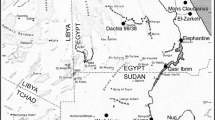Abstract
The existence of cannibalism is one of the most controversial issues in the archaeology of the American Southwest. Disarticulated, cut-marked and heat-altered human remains from non-burial contexts at prehistoric Puebloan (Anasazi) archaeological sites in the Four Corners region of the American Southwest have been interpreted by some scholars as evidence of cannibalism1. Osteological studies indicate that many of the disarticulated bodies found at these sites were processed in a manner consistent with food preparation2. Opponents of this interpretation point out that non-cannibalistic practices such as secondary interment, corpse mutilation and ritualized witch executions might account for the assemblages3,4,5,6,7. Osteological evidence alone does not document the actual ingestion of human flesh. Here we show consumption of human flesh did occur as demonstrated in preserved human waste containing identifiable human tissue remains from a site with osteological evidence of cannibalism.



Similar content being viewed by others
References
Turner, C. G. & Turner, J. A. Man Corn: Cannibalism and Violence in the American Southwest (Univ. of Utah Press, Salt Lake City, Utah, 1999).
White, T. D. Prehistoric Cannibalism at Mancos 5MTUMR-2346 (Princeton Univ. Press, Princeton, New Jersey, 1992).
Baker, S. Rattlesnake Ruin (42SA1853): A Case of Violent Death and Perimortem Mutilation in Anasazi Culture of San Juan County, Utah. Thesis, Brigham Young Univ., Provo Utah (1990).
Bullock, P. A reappraisal of Anasazi cannibalism. Kiva 57, 5–16 (1991).
Darling, J. A. Mass inhumation and the execution of witches in the American Southwest. Am. Anthropol. 100,732–752 (1999).
Nass, G. G. & Bellatoni, N. F. A prehistoric multiple burial from Monument Valley evidencing trauma and possible cannibalism. Kiva 47, 257–271 ( 1982).
Dongoske, K. E., Martin, D. L. & Ferguson, T. J. Critique of the claim of cannibalism at Cowboy Wash. Am. Antiquity 65, 179– 190 (2000).
Leonard, B. L., McAndrews, K. & Lambert, P. M. in The Puebloan Occupation of the Ute Mountain Piedmont Vol. 3 (ed. Billman, B.) Ch. 3 (Soil Systems Publications in Archaeology No. 22, Phoenix, in the press).
Billman, B. R., Lambert, P. M. & Leonard, B. L. Cannibalism, warfare, and drought in the Mesa Verde region during the twelfth century A. D. Am. Antiquity 65, 145–178 (2000).
Billman, B. R. The Puebloan Occupation of the Ute Mountain Piedmont: Synthesis and Conclusions, Vol. 7 (Soil Systems Publications in Archaeology No. 22, Phoenix, in the press).
Lambert, P. M. in The Puebloan Occupation of the Ute Mountain Piedmont Vol. 5 (ed. Billman, B.) Ch. 6 (Soil Systems Publications in Archaeology No. 22, Phoenix, 1999).
Lambert, P. M., Billman, B. R., & Leonard, B. L. Explaining variability inmutilated human bone assemblages from the American Southwest: A case study from the Southern Piedmont of Sleeping Ute Mountain, Colorado. Int. J. Osteoarchaeol. 10, 49–64 (2000).
Newman, M. E. in The Puebloan Occupation of the Ute Mountain Piedmont Vol. 3 (ed. Billman, B.) Appendix A (Soil Systems Publications in Archaeology No. 22, Phoenix, in the press).
Lambert, P. M. et al. Response to critique of the claim of cannibalism at Cowboy Wash. Am. Antiquity, 65, 397– 406 (2000).
Hammond, W. & Rathbun, F. Preliminary report of the 1998 excavations at Swallow site (5JF321>). Denver Chapter, Colorado Archaeological Society Report, 22–24 (1998).
Reinhard, K. J. in The Puebloan Occupation of the Ute Mountain Piedmont, Vol. 3 (ed. Billman, B.) Appendix B (Soil Systems Publications in Archaeology No. 22, Phoenix, in the press).
Minnis, P. E. Prehistoric diet in the Southwest: Macroplant remains from Four Corners feces. Am. Antiquity 54, 543– 563 (1989).
Reinhard, K. in Diet, Demography and Disease: Changing Perspectives of Anemia (eds Stuart-McAdam, P. & Kent, S.) 219–258 (Aldine de Gruyter, New York, 1992).
Vinton, S. D. Dietary Analysis of Coprolites from Northern Chile. Thesis, Univ. of Nebraska (1997).
Brown, P. & Tuzin, D. F. The Ethnography of Cannibalism (Soc. Psych. Anthropol. Publishers, Washington DC, 1983).
Chagnon, N. A. Yanonamö (Harcourt, Brace, Jovanovich College, Fort Worth, Texas, 1997).
Grayson, D. K. Donner party deaths: A demographic assessment. J. Anthropol. Res. 46, 223–242 ( 1990).
Keenleyside, A., Bertulli, M. & Fricke, H. C. The final days of the Franklin Expedition: New skeletal evidence. Arctic 50, 36– 46 (1997).
Acknowledgements
We thank T. G. Knight (Ute Mountain Ute Tribe), W. Hurley (Bureau of Reclamation), B. Harrill (Bureau of Indian Affairs), C. D. Breternitz (President of Soil Systems, Inc. and Principal Investigator) and C. K. Robinson (Projects Manager of Soil Systems, Inc.) for support of the excavation of 5MT10010; D. C. Kressin, A. Marlar and A. Schultz for help with the human myoglobin assay; the field crew at 5MT10010; and J. Merewether and M. Martin (Laboratory Directors for Soil Systems, Inc.). C. Murphy originally encountered the coprolite and E. Hansen first identified it as a human faecal deposit. R.M. thanks W. Hammond for encouraging the establishment of a biomolecular archaeology laboratory.
Author information
Authors and Affiliations
Corresponding author
Rights and permissions
About this article
Cite this article
Marlar, R., Leonard, B., Billman, B. et al. Biochemical evidence of cannibalism at a prehistoric Puebloan site in southwestern Colorado. Nature 407, 74–78 (2000). https://doi.org/10.1038/35024064
Received:
Accepted:
Issue Date:
DOI: https://doi.org/10.1038/35024064
- Springer Nature Limited
This article is cited by
-
Imaging coprolite taphonomy and preservation
Archaeological and Anthropological Sciences (2019)
-
An Optimized Approach for Protein Residue Extraction and Identification from Ceramics After Cooking
Journal of Archaeological Method and Theory (2012)
-
An effective method for deproteinization of bioactive polysaccharides extracted from lingzhi (Ganoderma atrum)
Food Science and Biotechnology (2012)





